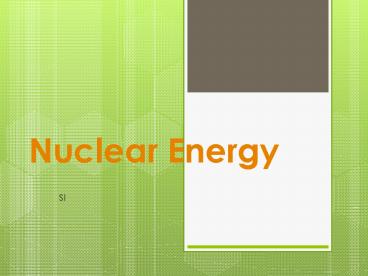Nuclear Energy - PowerPoint PPT Presentation
1 / 25
Title:
Nuclear Energy
Description:
Nuclear Energy SI A. What does radioactive mean? Radioactive materials have unstable nuclei, which go through changes by emitting particles or releasing energy to ... – PowerPoint PPT presentation
Number of Views:286
Avg rating:3.0/5.0
Title: Nuclear Energy
1
Nuclear Energy
- SI
2
A. What does radioactive mean?
- Radioactive materials have unstable nuclei, which
go through changes by emitting particles or
releasing energy to become stable - Call this nuclear decay
3
B. Types of Radiation
- Background Radiation radiation that the general
population is exposed to (ex. the sun, water,
plants) - Nuclear Radiation the particles that are
released from the nucleus during radioactive decay
4
Background Radiation
5
- 3. Alpha Particle a positively charged atom that
consists of two protons and two neutrons - Do not travel far through materials (cannot pass
through a piece of paper) - Symbol 42He
6
(No Transcript)
7
- 4. Beta Particle a negatively charged electron
emitted during radioactive decay - Fast-moving
- Can penetrate sheet of paper, but stopped by
piece of aluminum - Symbol 0-1e
8
d. A neutron turns into a proton and an electron.
The electron gets emitted from the nucleus.
9
- 5. Gamma Rays high-energy radiation emitted
during radioactive decay and nuclear fission - Gamma rays are a form of electromagnetic energy
- Not stopped by clothing or most building
materials, so are much more dangerous - Symbol ?
10
d) Atom goes from an excited state to a less
excited state. The nucleus does not change and a
gamma ray (unit of energy) is emitted from the
nucleus.
11
C. Decay Rates
- Half-life time required for half of a sample of
radioactive substance to decay - Use these decay rates to tell the age of rocks
and fossils (radiometric dating) - Carbon-14 is common isotope used in radiometric
dating
12
D. What makes a substance radioactive?
- Substances with too many or too few neutrons
- Substances with equal amounts of protons and
neutrons are stable - Which isotope is more stable?
- C-14 or C-12
13
E. What happens during nuclear decay?
- The parent element (starting substance) decays
into the daughter element (new substance) and
emits radiation - The daughter element can be an entirely new
element or an isotope of the parent element
14
II.) Nuclear Reactions
- A) Nuclear Fission the process by which a
nucleus splits into two or more smaller atoms and
releases neutrons and energy - In nuclear fission, tremendous amounts of energy
can be produced from very small amounts of mass
15
(No Transcript)
16
- Converting Mass into Energy
- Albert Einstein introduced the mass-energy
equation - E mc2
- According to the law of conservation of mass and
energy, the total amount of mass and energy
remains constant
17
- Triggering a Chain Reaction
- Nuclear fission follows a pattern of a chain
reaction - Chain reaction a continuous series of nuclear
fission reactions Fig 8 p.296
18
- Nuclear weapons are designed to have an
uncontrolled chain reactions - In controlled chain reactions, heat from the
reaction can be used to generate electrical
energy - Critical Mass the minimum amount of a substance
that can undergo a fission reaction and can also
sustain a chain reaction.
19
- Nuclear Energy From Fission
- Nuclear power plants generate about 20 of
electricity in the U.S. - Controlled fission of uranium-235 in a fission
reactor - Dont emit air pollutants, but have other safety
concerns - 1986 meltdown of reactor at Chernobyl nuclear
power plant in Ukraine
20
(No Transcript)
21
(No Transcript)
22
- Fusion the process in which smaller nuclei fuse
together at high temperatures and release energy - In nuclear fusion, tremendous amounts of energy
can be produced from very small amounts of mass - Releases more energy than nuclear fission
23
(No Transcript)
24
- Requires extremely high temperaturesi.e. Sun
reaches temp of 10,000,000oC - Fusion may someday provide clean and efficient
source of electricity
25
- Two problems creating a fusion reactor
- Need very high temperatures to start reaction
- Must contain plasma































